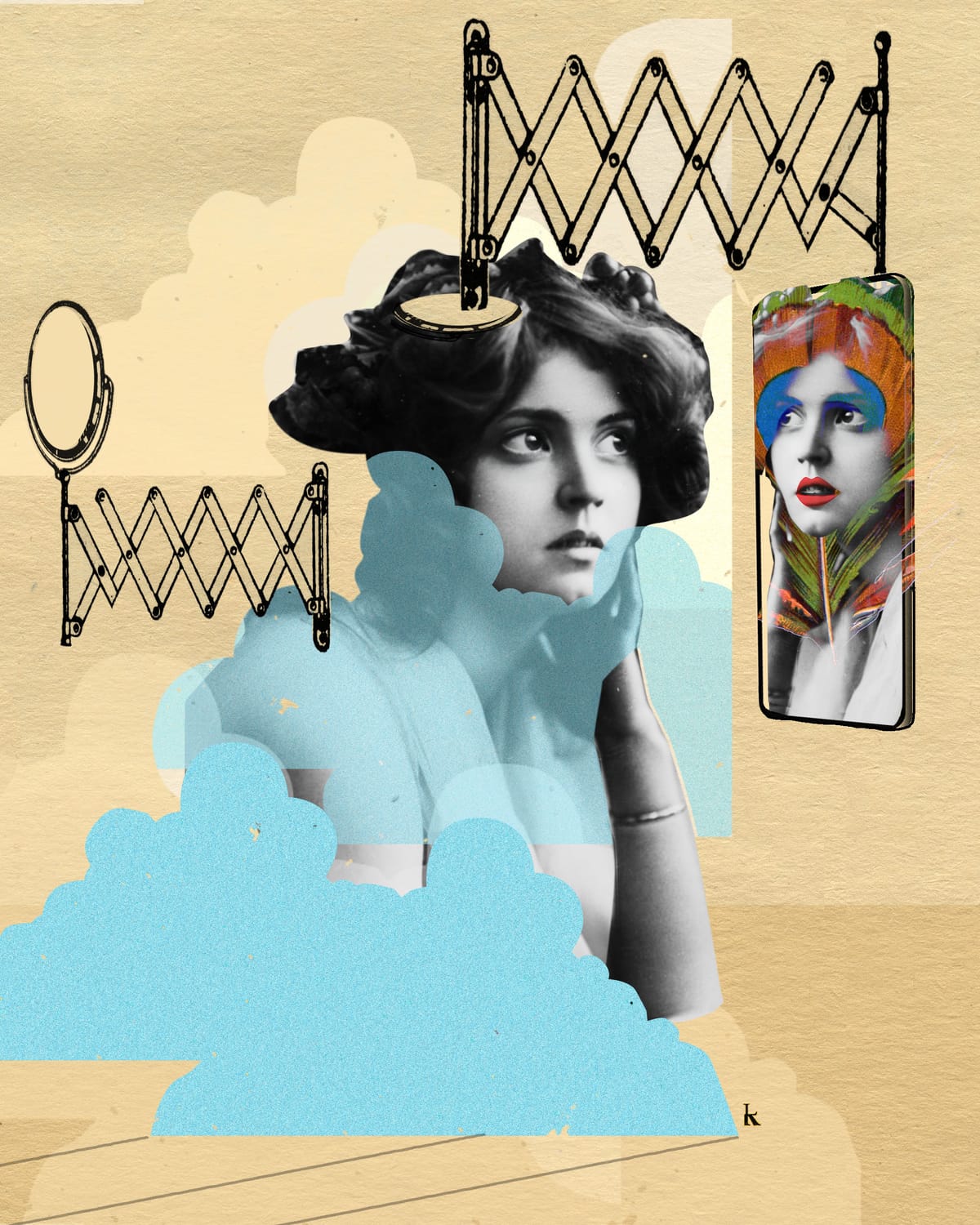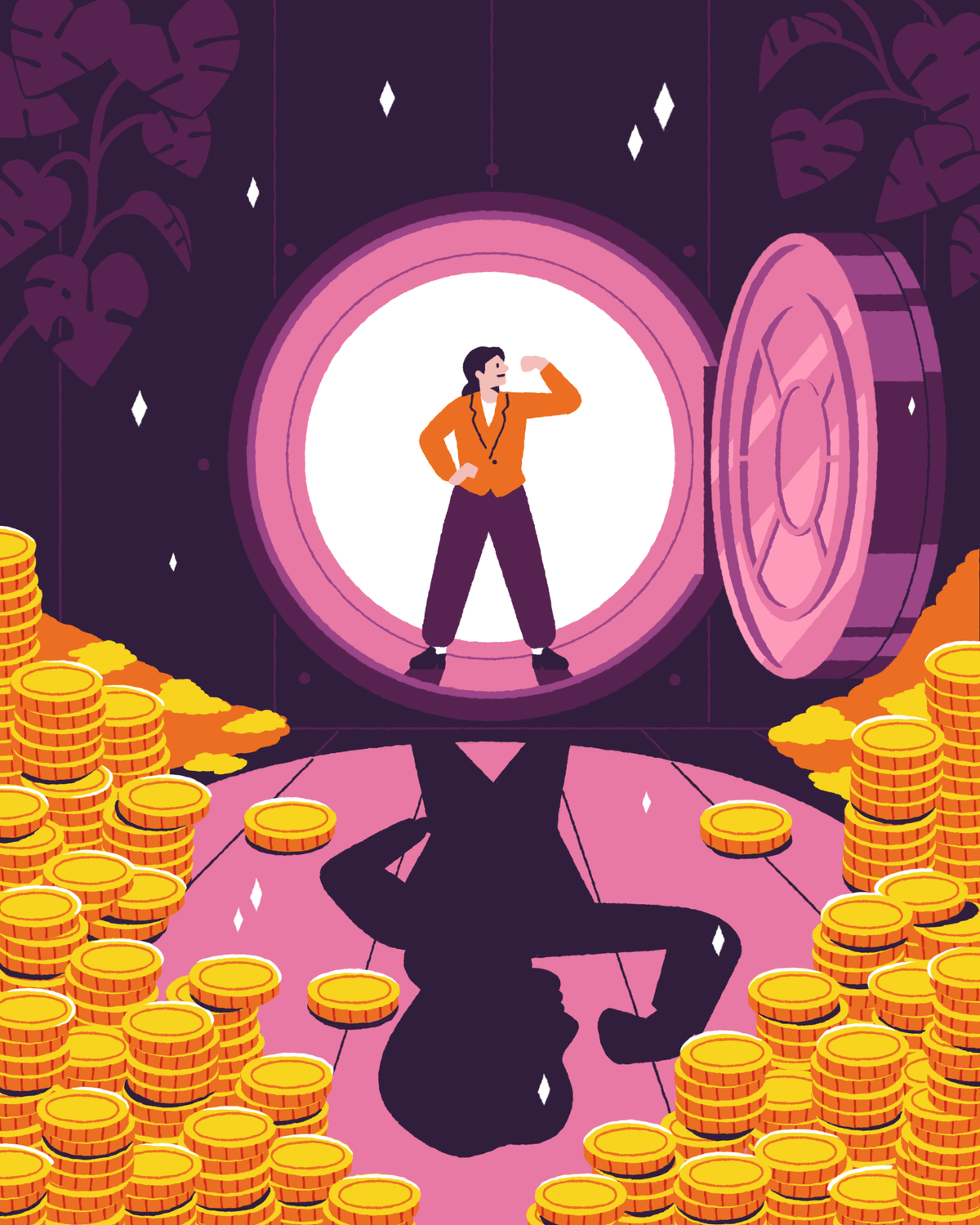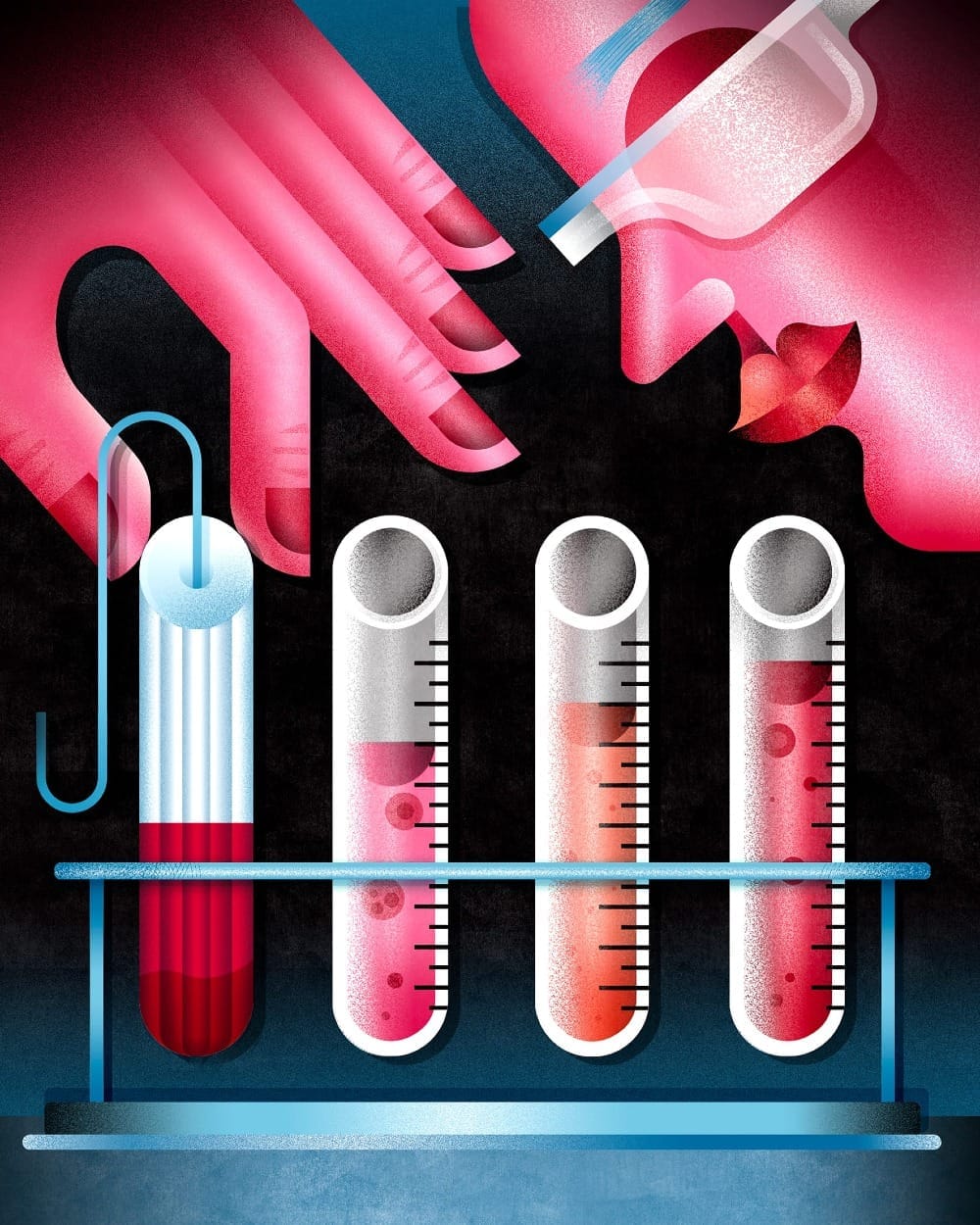AI Skews Beautiful. What Is That Doing to Us?
Images of people generated by AI tend to be gorgeous, even when creators ask them to be ugly. That could have a profound effect on our emotional wellbeing.

In recent months, my social media feeds have been filled with videos like this:
A woman stands on a stage in a floaty blue dress. She is very beautiful. She holds a peacock. Cut to the British TV talent show judge Cheryl Tweedy. She is dubious. Cut back to the woman. She wiggles her hips. Now she is the peacock! Or, her head is the head of a peacock—her body still that of a sexy woman. Cut back to Tweedy. She is amazed! She can’t believe it! The peacock woman performs a sexy dance. Behind Tweedy, the crowd goes wild!
Now, a different woman stands on a stage in an unflattering pink tracksuit. Overlaid text reads: “How is this possible?” The woman has lovely long brown hair and a beautiful smile and a very ordinary body: shapely thighs, a rounded stomach. She bows. Now she is thin! Cut to the British TV talent show judge Simon Cowell. His mouth is open and he is massaging his face because he is amazed! He can’t believe it! Cut back to the woman. She bows again. Now she is aging in reverse! She is a child! She is waving! Cut to the audience. They are absolutely losing their minds.
These are, of course, AI videos—and they are everywhere: On Instagram’s Recommended feed, all over X, on TikTok. They are unsettling, but there’s also a clear message to them: “Look at this beautiful woman. Look at her peculiar talent. She may have a peacock head, but she is nonetheless devastatingly beautiful, don’t you agree?” Or: “Look at this ordinary woman. Now she is beautiful! Thank goodness for her aesthetic improvement!”
In a 1970 essay, the robotics scholar Masahiro Mori came up with the term “uncanny valley” to describe the “sense of strangeness” and sudden loss of familiarity we experience when we realize a humanoid machine (or object, like a prosthetic limb) is not, actually, human. Or a robot is designed to look like a human but in its humanness, it looks even weirder than it would have looked, had it not been designed to look like a human at all. The brain is tricked into thinking it’s human, and when it realizes it isn’t, there is a sense of horror. I get the same creeping sense of weirdness when I look at, say, peacock lady: her skin is oddly smooth; her waist is a smidge too narrow for someone with real human organs; her arms move strangely. And then she’s a peacock.
In most cases, AI images and videos are still relatively easy to spot. But they are now becoming so widespread that that creepy feeling is beginning to dissipate. AI women—with their flawless skin, thick lashes, big eyes, and preternaturally symmetrical faces—are becoming normalized because, when we scroll through our social media feeds, images of them are almost seamlessly interwoven with pictures of real people. They are becoming the norm. What does this do to human beauty standards? To the way we actually look?
The Images Become a Deluge
In “The Beauty Myth,” (1990) Naomi Wolf explains how beauty only properly became a competitive sport in the 1830s, as photography became widespread and women were increasingly exposed to images of idealized beauty; images perhaps of what they should look like. Suddenly, beauty became a standard; a bar against which women might measure themselves.
Cut to the 2020s, and those images have become a deluge. Women spend up to three hours a day on social media. The platforms themselves know how harmful that is: One slide of a leaked internal presentation by Meta (then known as Facebook, Inc.), which owns Instagram, stated “We make body image issues worse for one in three teen girls.” Meanwhile, a clinical psychologist told a British government inquiry in 2020 that girls struggled “to ignore the ‘ideals’ pushed via social media.”
And that was before AI really took root in our social media spaces.
In January 2021, OpenAI first released DALL-E, the first widely-used text-to-AI generator, which allows a user to tell an AI what to draw using a written “prompt.” Since then, images of idealized beauty have become cheaper and easier than ever to produce. In 2023, it was estimated that 34 million images per day were being created using these generators. And there’s no arguing that when drawing women, they skew beautiful: I asked DeepAI, another generative AI, to generate 10 women and 10 men and the women were all unquestionably gorgeous. The men had a little more variation, with wrinkles, receding hairlines and gray hair (although they all looked eerily similar, as though they were all cousins). My results are below:


Defining Beauty
I’m hardly the first person to raise this concern. On Medium, Mike Koss, a self-described “software developer and hobbyist” wrote about how he experimented with different prompts using Midjourney, yet another AI text-to-image generator, and found that generic “woman” images were beautiful. When he added the word “ugly,” the AI generated old, unkempt or angry women.
An analysis by The Washington Post found similar results. Post reporters prompted three image-generation tools to generate “a full length portrait photo of a normal woman.” All the images created by the AIs were thin; 98% had light skin—although 40% had wrinkles and grey hair (but were nevertheless attractive).
“Ugly” women largely fell into two categories: actually quite beautiful, by most people’s standards, but with slightly mussed-up hair—or grotesque, with eyes that were alarmingly far apart and hollowed-out cheekbones, like a cartoon of an alien. A few were simply old and unkempt, with deep lines and messy hair.
AI “artists”, who regularly use generative AI to create images, don’t love this. I exchanged messages with Alex Strait, a former photographer who shares dozens of pieces of AI art each week on social media, including many images of women, says it’s a problem: Generators “default to beautiful.”
And you have to feel for the Reddit user who struggled to produce anyone not beautiful using Dall-E: “Even when I specifically gave it detailed text descriptions of a conventionally unattractive character…it would still come out looking very attractive,” they wrote in frustration.
What, actually, is beauty? We see it in a supermodel walking a runway, a blossom unfurling in the springtime, or a moment of tenderness between a parent and their child. Aristotle defined it as “order and symmetry and definiteness,” which he saw in the simplicity of a math equation. Immanuel Kant said beauty was in the eye of the beholder: A person’s response to an object is what defines its beauty, rather than the object itself. No wonder the poor AIs are confused.
I asked Kevin Baragona, DeepAI’s founder, to explain why AIs have such trouble with the concept of ugliness. DeepAI doesn’t train its own model, but he suggested that the training data may have had more images of beautiful women, or that the quality control people training the AI must “pick beautiful people.” Which means the model is learning to skew beautiful.
“Is any of this problematic? Quite possibly,” said Baragona.
‘This is misleading and weird’
Let’s be honest: Content created by generative AIs for social media, including whatever is going on with those peacock TikTok videos, tends to be at the lower end of the quality scale (referred to by some, not without justification, as “AI slop.”)
But it doesn’t stop there: AI is changing the game for high-end fashion and beauty brands as well—though for now, consumers don’t seem convinced.
Take a post by the denim brand Diesel. In it, a very tanned pair of septuagenarians are reflected in a bathroom mirror, both clad in denim. The camera flashes, and suddenly they are wearing nothing but their underwear, and they’re both posing, because they are both freakishly bronzed and toned. It’s clearly AI (the man’s surprisingly effeminate hand morphs as he raises it), and Diesel’s followers weren’t fans: “This is misleading and weird,” wrote one.
In April 2024 the Fanvue Miss AI, a beauty pageant for AI influencers, got a similar reception. Most of the “contestants” had been created by marketing agencies for the purposes of selling products—in the same way that real influencers and models do, but with fewer overheads.
The 10 contestants may have been fake, but the prize was real: the winner, a Moroccan “meta human” named Kenza Layli who was created by an organization called Phoenix AI, won $5,000 cash and a publicist to raise her profile. The judges—a mix of real-world beauty pageant judges and AI influencers—assessed the competitors on their appearance, use of AI tools and “social media clout,” how they engaged with their online followers.
One of the contest’s judges was Aitana Lopez, a pink-haired model who, according to her Instagram bio, is a “fitness lover” and a “gamer at heart.” She’s also completely fictional, dreamed up by the team at The Clueless Agency, a Barcelona-based modeling agency whose roster of 30 AI-generated models have appeared in ads for the likes of Sony and Audi, for which it created a “face” for its (female, of course) virtual assistant. (Naturally, the assistant is named Ai.leene.)
What’s striking about The Clueless Agency’s models is that, unlike the women produced by generative AIs, they are all different: different ages, sizes and ethnic backgrounds. Brands can pick between Penélope, a 74 year-old “free spirit” with long hair, very discernible laughter lines and a realistically scraggy neck; Aaliyah, a 24 year-old, dark-skinned Kenyan; or Laila, a plus-sized Guatemalan polyglot who is “always looking for a bargain.” In keeping with AI tradition, there are no pores in sight—but there are very human wrinkles and messy hair. In a hot way, though.
Miel Cordero from The Clueless Agency told me over email that the models’ “level of realism is so impactful that each one has its own story and is capable of creating authentic connections with the audience.” In other words, their imperfections make them seem more human. Uncanny valley, begone.
“It's about control, consistency, and flexibility. With AI, brands can personalize campaigns in detail, adapt visual identities without restrictions, and avoid unforeseen issues common in the traditional industry.” It’s also cheaper. Also: “AI models do not get tired, do not have schedules, and can work on multiple projects at the same time, opening new opportunities for brands and creators.”
Wrinkles, But Sexy
The problem is that The Clueless Agency’s models are just as unrealistically attractive as other AI creations. It’s something with which mere mortals just can’t compete. And AI models are everywhere on our social media feeds: Lu do Magalu, Instagram’s most-followed AI influencer, has 7.6 million followers, while the runner-up, the pixie-faced LilMiquela, has 2.4 million. One study last year estimated that 65.5% of the female social media audience had interacted with a virtual influencer.
This sort of perfection has a profound effect on our brains, says Eloise Skinner, an existential therapist, who helps her clients to make sense of their place in the world. “Young women in particular are exposed to so much content,” she says. “You’re trying to figure out, ‘who actually am I?’ And how should I present myself to the world?” she says.
Idealized images of beauty just make them feel like failures. “There's a lot of identity building going on at that stage and [a lot of online content] can be really disruptive. You feel like, ‘I actually have no idea what I'm meant to aspire to, or how I can live up to these ideals.’”
Dr. Ed Robinson, who runs two aesthetics clinics, one on Harley Street in London and the other in Altrincham, in the North of England (where a lot of British soccer players and their wives live), says “a lot of patients bring in AI-enhanced photos of themselves…and then ask if I can make them look like that. And I’m like, well, that’s not reality,” he says.
“They’re trying to achieve a reality that doesn’t exist.”
But It’ll All Be Fine
This is the point in this piece where I am supposed to offer hope.
Yes, AI is taking over the internet and yes, it skews gorgeous and yes, we are all going to see a lot more beautiful cyborg women (and men) of varying levels of quality as time goes on. For now, governments are not doing a great job stemming this tide: At a summit in Paris this February, two major nations—the U.K. and the U.S.—refused to sign an international agreement aimed at making AI safer because, in the U.K.’s case, it “hadn’t been able to agree all parts,” and in the U.S.’s case, it didn’t want to “kill a transformative industry just as it’s taking off.” In total, 64 countries did sign the agreement, including the rest of the G7.
That leaves the responsibility to us, the consumers, to protect ourselves. Skinner, the therapist, says it can take the form of simply “finding your own sense of identity, finding a sense of self value and figuring out who you are independently of online content.”
That’s an interesting turn of phrase, I tell her. It implies that scrolling through online content is sucking away your personality. “Yes,” she replies. “You can scroll TikTok for hours and not even notice that you haven't been present in your own life. There's an option now to opt out of being with yourself, even when you're alone.”
It’s tempting to say that AI can’t offer us what we all love about being human—a wonky eyebrow here, a laughter line there. But that’s not true—the gorgeously “flawed” models with their occasional wrinkles or messy hair from The Clueless Agency prove that.
So perhaps what is needed is a new era of radical acceptance: Sure, we’ll never be as devastatingly perfect as cyborgs, but at the same time, they’ll never have what we have. Because yes, AI skews beautiful. But humans skew smart and thoughtful and funny and unique.
And maybe one day, it’s precisely that crooked eyebrow or lopsided smile we’ll all be clamoring for. Maybe that’ll be the thing we covet. To quote those great poets, the 1970s soul band The Chi-Lites: If everybody looked the same, we’d be tired of looking at each other.











